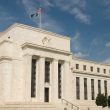by Hubert Marleau, Market Economist, Palos Management
September 22, 2023
The Federal Open Market Committee held a 2-day, high-stakes meeting last week that was particularly important, even though there was no subsequent change in the policy rate. The Fed officials elected to hold interest rates between 5.25% and 5.50%, but signalled that they might raise them one more time this year with, however, less conviction than in June, and that they were more willing to keep them near their current level throughout 2024. This message was formulated in a way to prevent investors from getting too optimistic about future rate cuts, even if confident that inflation will continue to move down sustainably, and that stronger-than-anticipated economic activity will hold.
The monetary officials increased their projections for economic growth to 2.1% in 2023 and 1.5% in 2024, compared to 1.0% and 1.1% respectively in June, without any meaningful change in the inflation forecast. PCE inflation is expected to be 3.3% in 2023, 2.5% in 2024 and 2.2% in 2025, essentially the same as the June projections. These forecasts are based on the notions that monetary policies operate with lag and that households are about to run out of their excess savings.
Why in hell did the Fed deliver a hawkish pause? Through confidence that it will not create a credit crunch and be able to pull-off a soft-landing? Yes, the decision was not to curtail inflation, but to nudge growth lower, rather than the other way around. It bought into the NY Fed’s own assessment that the downside risk to real GDP growth remains at historically normal levels, with the estimated conditional probability of average growth over the next 4 quarters falling 1% to only 15%.
With no incentive to be dovish, bond and stock prices were hit hard. The 10-year Treasury yield jumped to 4.41% and the S&P 500 fell 0.94%. The good news was a decrease in the price of oil and an increased value of the dollar, suggesting the possibility that the policymakers might change their minds. Indeed, there have been 4 exogenous shocks - the rising price of oil, the strength of the dollar, the increase in interest rates, and the ascent of productivity - the weight of which could change everything around. What is crucial is that investors have accepted the Fed’s prediction of “High for Longer” at face value. History, however, is not on the Fed’side on this one. I love James Mackintosh, a commentator with the WSJ, for remarking that rates go up the stairs, but come down the elevator. Nor do I buy the Fed’s interest rate projections.
Will Rising Oil Prices Last? No
The months-long oil rally has sent prices close to $100 a barrel, where several analysts have their forecast. Brent crude, the global benchmark, rose above $95 a barrel, registering a huge gain of 30% since June. This surge was caused by Saudi Arabia and Russia's decision to extend production cuts to the end of the year, removing more than a million barrels a day from the market, while global demand, particularly in China remains robust and conditions in the spot market are extremely tight. Commercial interests, however, do not seem to believe that the sizable rally is sustainable. Interestingly, the Bloomberg Industrial Metals Index, which is composed of futures contracts on copper, aluminium, zinc, nickel and lead, has been gyrating in a narrow trading range since May and is clearly not conforming to the upward performance of oil. Moreover, there has been a tremendous divergence between the price of oil and the performance of petrocurrencies. Canada and Norway’s petroleum account for 20% and 40% respectively of total domestic exports, and not much has happened with their currencies.
This tells me that the momentum should fade over the coming months. History shows that when energy bills claim too high a share of world GDP, which is getting to 6.7%, and is up 1.2 percentage points over the past 3 months, Opec usually softens up. Indeed, Prince Abdulaziz, Saudi Arabia’s energy minister, may have made a Trudeauian mistake if he is indeed correct that the decision was not about jacking up the price of oil but about balancing things out. The International Energy Agency notes that the Kingdom holds 3.3 million barrels a day of spare capacity.
This explains why 1) refiners have pulled oil out of storage rather than using current production to supply customers; 2) investors have not bid up small oil and gas producers, who are significantly cheaper than the majors; and 3) there are reports that China might be done with filling its oil reserves. Moreover, unlike what happened in the 1970s, the current spike was not triggered by Middle East wars. On the contrary, the U.S. is discussing terms of a mutual defence treaty with Saudi Arabia that resembles military pacts with Japan and South Korea and would normalise the Kingdom’s relations with Israel. There you have it: the futures market is predicting a drop-off in oil prices next year, with Brent futures expiring next July at $86.
Will the Dollar Rise? Yes
Given the hawkish tone of the Fed and its belief that it can add additional pressure on financial conditions through 2025 with hardly any cost to the economy, the dollar can only strengthen. Indeed, the technical team at the BofA is of the opinion that the rally of the DXY will continue. The DXY, a most important barometer, measures the value of the US Dollar versus a basket of global currencies as up 6% from a July low, and thus on track to form a golden cross, which is a very bullish sign. Reuters reported that the last time this happened the DXY went on to rise another 24%.
Will Productivity Rise? Yes
Productivity growth which bottomed out at 0.4% during Q4 of 2015, rose to 1.4% during 4Q of 2019, zigzagging all over the place during the pandemic to settle down at 1.6% in Q2/2023. We have entered a golden age of technological innovation and investment, the benefit of which will likely favour industry rather than consumers. The rapid explosion of generative AI, combined with sensors, robotics and logistic software will be reserved for traditional legacy industries, such as manufacturing, transportation, logistics and healthcare, for general use. Approximately 75% of the world’s $100 trillion in gross domestic product is concentrated in these industries; and a recent study conducted by Reuters and PGIM revealed that the value of this golden age could add as much as $15.7 trillion to the global economy by 2030. In this connection, productivity growth will resume its pre-pandemic ascent and bring productivity to 4.0% by 2030. It may seem far-fetched, but Yardeni Research knows that this is consistent with peaks in previous productivity growth cycles.
Will Interest Rates Rise? No
Despite all of the Fed’s harsh talk that rates will be high for longer, investors are certainly less convinced that more tightening is coming. Expectations for rates at the end of next year have risen, but they are still well below the Fed’s, at about 4.7%. If it is serious about wanting a soft landing, the latter may have to water down its wine. The Conference Board’s Index of Leading Economic Indicators showed a drop of 0.4% in August, following a decline of 0.3% in July, and it’s been falling since December 2021. With debt rising relative to debt and bank lending standards tightening, both the velocity and supply of money is bound to fall and, in turn, lower nominal GDP growth. Given the resilience of the labour market and the ascent of productivity, most of the effects of the monetary conditions will likely fall on inflation. In fact, inflationary pressure continues to ease.
The Adobe Digital Price Index, fell 3.2% y/y in August, hitting a 12-month low and registering the 12th consecutive month of y/y declines, while 11 of the 18 categories of online goods saw prices fall on an annual basis. Backing this is the Underlying Inflation Gauge, produced by the NY Fed, which fell another 0.1% in August for a y/y increase of 3.0%, generating a CPI trend inflation as low as 2.3%. At best, N-GDP will grow 4.0% in 2024, with many private forecasters pegging it at only 3.0%. In this connection, the 10-year Treasury yield should at the very least consolidate around here at 4.50%, with good chances that it may end up lower.
Will the Stock Market Rise? Yes and No
The S&P 500 is down 262 points or 5.7% from its July 25 bull market bull peak. That's because the 10-year bond yield climbed 70 bps to 4.50%. Neither market likes good news at the moment. Both were jolted equally, the stock market shedding about 4 points for every 1 point rise in yield, which is just about right, forward P/E being inversely correlated with the 10-year TIPS yield, which is also up 70 bps to 2.15% from 1.45%.
The S&P 500 closed at 4320 on Friday and is currently below its 50-day moving average (4481). That’s short term bearish but the benchmark should find a lot of support at its 200-day moving average (4200). Moreover, the Dow Jones Transportation Index, a reputable leading indicator of the broader market, closed at 235.75 on Thursday, a level where the 200-day moving average currently stands: perhaps, precarious, but definitely oversold, offering support to the bulls.
Thus the S&P 500 could fall another 2.8% from this point, but a year-end rally back to 4750 can be anticipated should some or all the aforementioned factors happen as I expect, which is to say that oil prices stabilise or dip, the 10-year Treasury yield stabilises or falls, the dollar stabilises or nudges up, and productivity gains a few more notches. Then there is the auto worker strike to contend with, along with the potential government shutdown. I have no idea, however, where these two are going: way too political for me to understand.
Copyright © Palos Management















